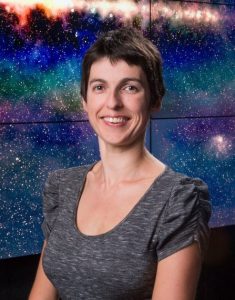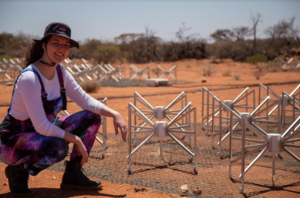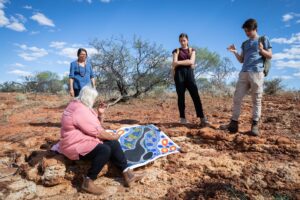ICRAR researchers are finalists in three of the six categories in this year’s Premier’s Science Awards. These Awards recognise and celebrate the outstanding scientific research and engagement taking place in Western Australia.
HBF Mid-Career Scientist of the Year
Awarded to an outstanding scientist who completed their highest degree between five and fifteen years ago, and has demonstrated excellence in a field of science, scientific research or technological advancement.

Natasha Hurley-Walker Image: ICRAR/Curtin
Dr Natasha Hurley-Walker
ICRAR/Curtin
Dr Natasha Hurley-Walker has transformed our view of the radio sky. She uses powerful supercomputers to analyse petabytes of data from Western Australian telescopes to explore our Universe. Her discoveries include the remains of stellar explosions, insights into the lives of supermassive black holes, and a new kind of repeating radio source unlike anything astronomers have seen before. Giving public talks, media interviews, and filming for documentaries, she has reached tens of millions across the world, inspiring interest in STEM careers. Her work path-finds toward the Square Kilometre Array, which will be the world’s largest radio telescope, here in Western Australia.

A/Prof Danail Obreschkow
Associate Professor Danail Obreschkow
ICRAR/UWA
A/Prof Obreschkow is an astrophysicist at The University of Western Australia (UWA) node of the International Centre of Radio Astronomy Research (ICRAR). He is a Future Fellow of the Australian Research Council and the Director of UWA’s International Space Centre (ISC). Danail’s main research passion lies in the dynamics of galaxies, which holds important clues to understanding our own existence in the cosmos. His exceptionally broad research record, sustained success in winning large competitive grants, leadership in space and astronomy, as well as his dedication to science communication, make him a prominent figure in Western Australia’s research sector.
ExxonMobil Student Scientist of the Year
Awarded to an outstanding postgraduate student who has demonstrated a commitment to science at an early stage and shows great promise in reaching the highest levels of excellence.

Kat Ross
Kat Ross
ICRAR/Curtin
Kathryn Ross is a postgraduate research student based at the Curtin Institute of Radio Astronomy and the International Centre for Radio Astronomy Research. She studies supermassive black holes in the centres of galaxies, focusing on baby black holes that are smaller than typical galaxies. Using telescopes around Australia, Kathryn discovered these black holes are not as young as previously thought, but frustrated teens being restricted by a surrounding cloud of gas. She is a science communicator promoting STEM to audiences nationally and internationally. Kathryn is also an activist leading a national campaign, IncludeHer, working to diversify the representation of scientists in schools.
Chevron Science Engagement Initiative of the Year
Recognises an initiative that has made an outstanding contribution to community awareness, interest and/or participation in science in Western Australia.

Yamaji Arts artist Margaret Whitehurst discusses her painting ‘The Emu in the Sky’ with Charmaine Green, Lucia Richardson & Max Winton. © Prospero Productions 2020
Star Dreaming
Curtin University / International Centre for Radio Astronomy Research / Yamaji Art / Prospero Productions / Last Pixel
Star Dreaming is a 180-degree immersive film experience that follows two children from Geraldton as they discover the Square Kilometre Array and the Yamaji culture of the Traditional Owners of the land on which it is built. The film explores science, art, technology and Indigenous culture side-by-side. Awarded the Best Astronomy Education award at the Dome Under Festival, its opening season at the WA Maritime Museum in Fremantle was experienced by thousands of people. Selected by international film festivals, it will be distributed internationally and will be Western Australian science and culture to the world.
Winners will be announced at the Awards Ceremony on 29 August, after National Science Week.